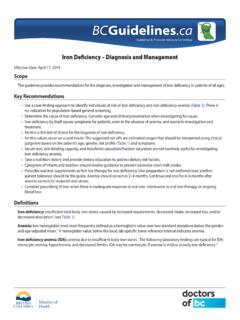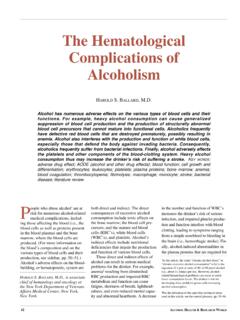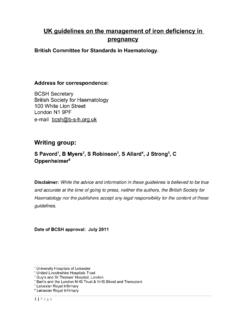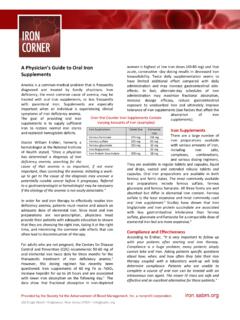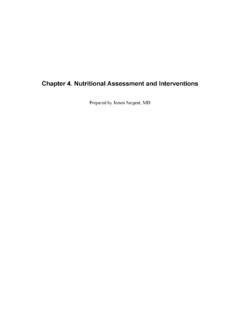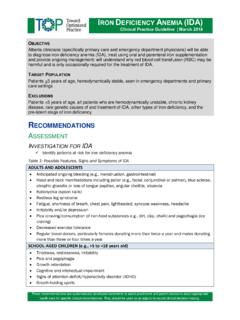Transcription of Iron and Health - GOV.UK
1 iron and Health2010 iron and HealthScientific Advisory Committee on Nutrition2010 London: TSOP ublished by TSO (The Stationery Office) and available , Telephone, Fax & E-mailTSOPO Box 29, Norwich, NR3 1 GNTelephone orders/General enquiries: 0870 600 5522 Fax orders: 0870 600 5533E-mail: 0870 240 3701 TSO@Blackwell and other Accredited AgentsCustomers can also order publications from: TSO Ireland16 Arthur Street, Belfast BT1 4 GDTel: 028 9023 8451 Fax: 028 9023 5401 Further copies can be obtained from the SACN website at Crown copyright 2010 Published for the Department of Health under licence from the Controller of Her Majesty s Stationery 978 0 11 706992 3 Printed in the United Kingdom by TSO (The Stationery Office).J002267922 C3 1/11iiiPrefaceIn 1998, the Committee on Medical Aspects of Food and Nutrition Policy (COMA), in their report, Nutritional Aspects of the Development of Cancer, recommended that high consumers of red and processed meat should consider reducing their intakes because of possible links with a risk of colorectal cancer.
2 However, since red and processed meat are sources of iron in the UK diet, COMA recommended that the possible adverse nutritional implications of a reduction in red and processed meat intakes should be assessed. The present report has been prepared in response to COMA s report provides a comprehensive review of the role of iron in human nutrition which was drawn from an extensive body of literature. The scope of the report was wide-ranging and included consideration of potential adverse effects both of iron deficiency and of iron excess. The Scientific Advisory Committee on Nutrition (SACN) also assessed the adequacy of iron intakes and status of the general and low income populations in the UK. There are difficulties in making these assessments because of uncertainties around the dietary recommendations for iron intake, which are based on limited data, and because the thresholds of biological markers used to define iron status are not related to functional consequences.
3 The potential implications of a recommendation to reduce consumption of red and processed meat on intakes of iron were assessed by modelling data from the National Diet and Nutrition Survey (2000/01).For the general population, SACN is recommending a public Health approach to achieving adequate iron status based on a healthy balanced diet that includes a variety of foods containing iron . This is a change to current dietary advice that iron -rich foods should be consumed at the same time as foods/drinks which enhance iron absorption ( , fruit, meat) but should not be consumed with those that inhibit iron absorption ( , tea, coffee, milk).Groups identified as being at risk of iron deficiency anaemia include toddlers, girls and women of reproductive age, and some adult groups aged over 65 years.
4 The report recom-mends that Health professionals need to be aware of increased risk of iron deficiency anaemia in these groups and those with evidence suggestive of iron deficiency anaemia should receive appropriate clinical assessment and advice, including dietary advice and the use of iron supplements if detailed consideration of the epidemiological evidence on the relationship between red and processed meat intake and colorectal cancer risk, the report concludes that red and processed meat is probably associated with an increased risk of colorectal cancer. Since the evidence does not allow quantification of the amount of red and processed meat that may be linked with increased colorectal cancer risk, SACN is advising high consumers of red and processed meat to consider reducing their intakes.
5 The modelling exercise suggests that reducing red and processed meat intake to the population average for adult consumers (estimated to be about 70 g/day cooked weight in 2000/01) would have little effect on the proportion of the population with iron intakes below the lower limit of recommended intake for of this report has been a lengthy process and has taken longer than originally envisaged. In part, this is because work on the report (which commenced in 2002) was suspended from 2006 to 2008 due to other SACN priorities, but also because of the innate complexity of the draft report was made available for comment and I would like to thank all those who responded. All the comments were carefully considered before the report was finalised. I would also like to thank the members of the iron Working Group for their commitment and continued work on the report over the years, particularly the Chair, Professor Peter Aggett, and the scientific Alan Jackson Chair of the Scientific Advisory Committee on NutritionvContentsPreface iiiMembership of the Scientific Advisory Committee on Nutrition.
6 iron Working Group ixMembership of the Scientific Advisory Committee on Nutrition xiSummary 11 Introduction 10 Background 10 Terms of reference 11 Methodology 112 Biochemistry and metabolism 13 Function 13 Metabolism 14 iron losses 15 Absorption 15 Plasma iron transport 18 Hepatocyte iron uptake 19 iron storage and deposition 19 Cellular iron homeostasis 19 Response to increased systemic iron needs 20 Inborn errors of iron metabolism 20 The effect of infection and inflammation on iron metabolism 233 Physiological requirements 25 Current recommendations for iron intake in the UK 25 Population groups 274 Measuring iron status: markers of depletion, deficiency , sufficiency and excess 37 iron status 37 Establishment of reference values for markers used to assess iron status 38 Markers of iron status 39 Assessment of iron status in infants and young children 47 Assessment of iron overload 485 iron in the diet 51 Dietary iron 51 Bioavailability of dietary iron 51 Measuring bioavailability and absorption of dietary iron 53 Dietary factors influencing iron absorption and bioavailability 54viThe influence of enhancers and inhibitors of iron absorption on iron status 60 Fortification iron 67 Effect of iron fortification on iron status 69 Supplements 72 The effect of vegetarian diets on iron status 726 Health consequences of iron deficiency 76 Physiological consequences of iron deficiency 76 Causes of iron deficiency and anaemia 76 iron and physical
7 Work capacity 77 Maternal iron status and pregnancy outcome 83 Cognitive, motor and behavioural development in children 867 Health consequences of high iron intake and high iron burden 97 Recommended upper intake levels for iron 97 Acute iron toxicity 98 Physiological consequences of high iron intakes and overload 98 Health consequences of high iron intakes 102 iron and cancer 103 Meat and colorectal cancer 106 iron and cardiovascular disease 111 Other effects of high exposures to iron 1138 Effect of iron deficiency and excess on immunity and infection 120 The immune response 120 Effects of iron deficiency on immune function 120 Effects of iron overload on immune function 121 Effects of iron supplementation on infection 121 iron and human immunodeficiency virus (HIV) infection 124 iron and tuberculosis (TB) 1259 Dietary iron intakes and iron status of the UK population 127 Assessment of iron intakes 127 Assessment of iron status 128 iron intakes of the UK population 129 Comparison of iron intakes with Dietary Reference Values 131 iron status of the UK population.
8 Evidence of anaemia, iron deficiency and iron deficiency anaemia 132 Relationship between iron status markers and iron intakes 134 Further analysis of specific age-groups in the NDNS series 135 iron status of minority ethnic groups 136 iron intake and status in infants and young children up to 18 months 137vii10 The potential impact of reducing red and processed meat consumption on intakes of iron and zinc 141 Modelling exercise 141 Methods and assumptions 142 Results of modelling exercise 143 Interpretation of results from the modelling exercise 148 Limitations of the modelling exercise 14911 Overall summary and conclusions 15112 Recommendations 16213 Research recommendations 164 References 165 Annexes1 SACN working procedures 2082 Examples of functional iron -containing proteins in the body 2103
9 International dietary reference values for iron 2114 Existing public Health advice to improve iron nutrition in the UK 2135 Studies considered in relation to iron in the diet 2166 Studies considered in relation to iron and cognitive function 2337 Studies considered in relation to iron and risk of colorectal cancer and cardiovascular disease 2678 Consideration of possible mechanisms to explain the association between colorectal cancer risk and red and processed meat intake 2929 iron intakes and status of the UK population 32110 Preliminary iron intake data from year 1 of the NDNS rolling programme (2008/09) 33111 Modelling the impact of reductions in red and processed meat consumption on intakes of iron , zinc and vitamin D 33312 Explanation of adjustment made to meat consumption estimates in the 2000/01 NDNS and the NDNS rolling programme year 1 (2008/09) to enable comparison between surveys 35213 Glossary 354viiiixMembership of the Scientific Advisory Committee on Nutrition.
10 iron Working GroupChairman Professor Peter Aggett Honorary Professor, School of Medicine and Health , Lancaster Chairman Dr Ann Prentice Director, Medical Research Council Human Nutrition Research, Professor Philip Calder Developmental Origins of Health and Disease Division, School of Medicine, University of Sue Fairweather-Tait Personal Chair in the School of Medicine, Health , Policy and Practice, University of East Sally Grantham-McGregor Centre for International Child Health , Institute of Child Christine Gratus Honorary Senior Research Fellow, University of Birmingham, School of Primary Care Clinical Sciences. Former advertising and marketing research Timothy Key Professor in Epidemiology and Deputy Director of Cancer Epidemiology Unit, University of Joe Lunec Head of Cranfield Health , Cranfield Kim Fleischer Michaelsen Research Department of Human Nutrition, Royal Veterinary and Agricultural University, Martin Pippard Dean of the Medical School, University of Mark Worwood Emeritus Professor, Cardiff University and Honorary Clinical Scientist, Cardiff and Vale NHS Standards AgencyDr Alison Tedstone (Scientific)Ms Mamta Singh (Scientific)Ms Rachel Elsom (Scientific) (until February 2005)Contributions from:Ms Cath Mulholland (Scientific)Ms Rachel Stratton (Scientific)Mr Frederick Wheeler (Statistics)Department of HealthDr Sheela Reddy (Scientific)AcknowledgementsThanks to Dr.











